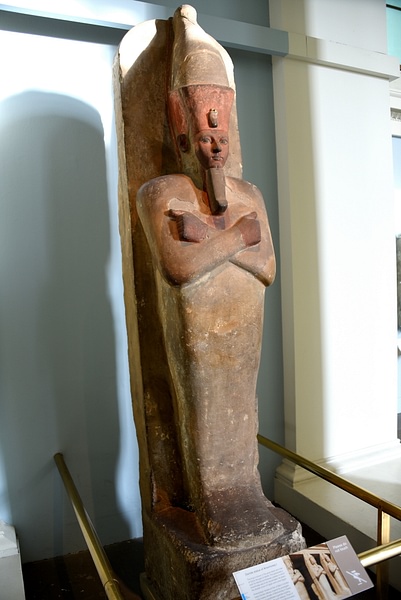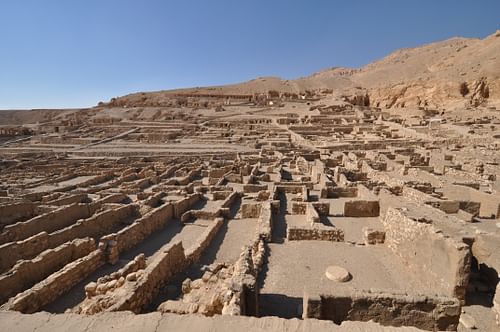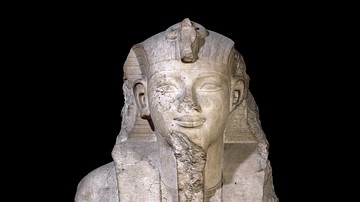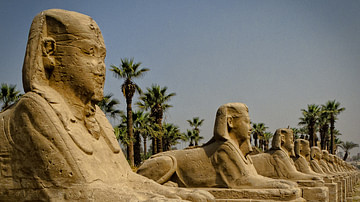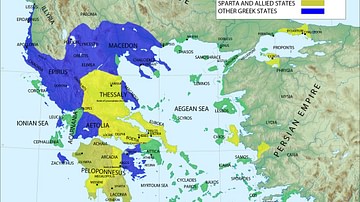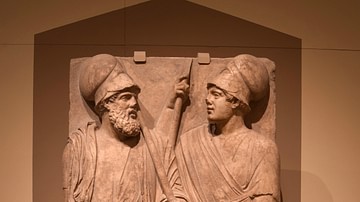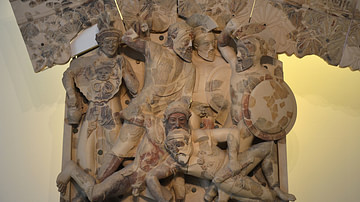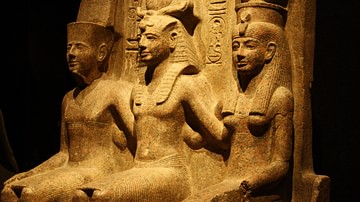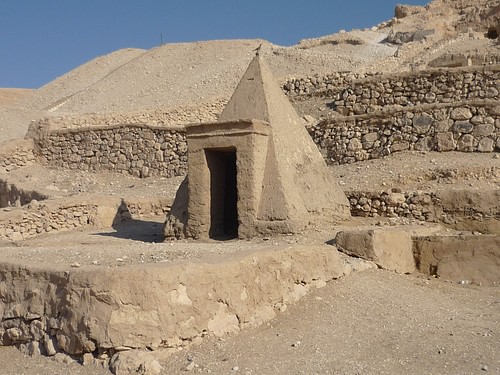
Deir el-Medina is the modern Arabic name for the worker's village (now an archaeological site) which was home to the artisans and craftsmen of Thebes who built and decorated the royal tombs in the nearby Valley of the Kings and Valley of the Queens.
The ancient inhabitants called the village Pa Demi (“the village”) but it was referred to in official correspondence as Set-Ma'at (“The Place of Truth”) because the workers there were thought to be inspired by the gods in creating the eternal homes of the deceased kings and their families. Early in the Christian era the village, then deserted, was occupied by monks who took over the Temple of Hathor for use as a cloister. The temple was referred to as Deir el-Medina (“Monastery of the Town”) and this name finally came to be applied to the entire site.
Unlike most villages in ancient Egypt, which grew up organically from small settlements, Deir el-Medina was a planned community. It was founded by Amenhotep I (c.1541-1520 BCE) specifically to house workers on royal tombs because tomb desecration and robbery had become a serious concern by his time. It was decided that the royalty of Egypt would no longer advertise their final resting places with large monuments but, instead, would be buried in a less accessible area in tombs cut into the cliff walls. These areas would become the necropolises now known as the Valley of the Kings and the Valley of the Queens and those who lived in the village were known as “Servants in the Place of Truth” for their important role in creating eternal homes and also remaining discreet regarding tomb contents and location.
Deir el-Medina is among the most important archaeological sites in Egypt because of the wealth of information it provides on the daily life of the people who lived there. Serious excavation at the site was begun in 1905 CE by the Italian archaeologist Ernesto Schiaparelli and furthered by a number of others throughout the 20th century CE with some of the most extensive work done by French archaeologist Bernard Bruyere between 1922-1940 CE. At the same time Howard Carter was bringing the treasures of the royalty to light from Tutankhamun's tomb, Bruyere was uncovering the lives of the working people who would have created that final resting place.
History of the Village
The earliest extant ruins at the site are from the reign of Thutmose I (1520-1492 BCE), son and successor of Amenhotep I, but there is no doubt that it was Amenhotep I who first planned the site. He and his mother, Ahmose-Nefertari, were worshipped as protective gods at the site throughout its history. The workers also venerated the cobra goddess Meretseger (whose name means “She Who Loves Silence”), the personification of the Theban necropolis and protector of the dead and, especially, of their tombs.
By the time of the New Kingdom (c.1570-c.1069 BCE) tomb robbing had become almost epidemic in scope. Although measures such as false doors and labyrinths had been a part of tomb building since the Old Kingdom (c.2613-2181 BCE) they were not effective in keeping robbers from reaching the burial chamber and the vast treasures left there with the deceased. One gains an understanding of exactly how great the wealth in these tombs was when one considers the treasures of Tutankhamun's tomb discovered by Howard Carter in 1922 CE. Tutankhamun died before he was 20 years old and had not yet amassed the kind of wealth a king like Djoser (c.2670 BCE) or Khufu (2589-2566 BCE) would have had entombed for the afterlife.
The Valley of the Kings was selected as the new necropolis for royalty and the village was planned for easy access (a half hour's walk) from a worker's home to the tombs. The village was in continuous use from the time of Thutmose I until the collapse of the New Kingdom in c. 1069 BCE. Although the community and nearby necropolises were planned to safeguard the tombs of the kings, human greed and opportunity would eventually work to undermine the plan and some of the workers themselves would turn to robbing the tombs they had helped build and protect for an easy and quite substantial payoff. For most of its history, however, the village seems to have functioned as it was intended.
Homes & Layout
The community was laid out in a rectangular grid pattern surrounded by a protective wall and occupied an area of 1.4 acres (5,600 meters) with 68 houses inside the wall and others, belonging to less-skilled workers, located on the slopes of the mountains outside the wall. There was a main entrance in the north wall with a “guard house” next to it and another in the south. The actual purpose of the “guard house” structure is debated by scholars. Although it would appear to be an actual guard house, it may have served another purpose. To the east and west were the worker's cemeteries and, not surprisingly, these featured many elaborate and beautiful tombs.
The homes were tightly packed together to make the most of the available space. The village was situated, quite literally, in the middle of the desert in order to separate its occupants from the rest of the population. The site was the flat land at the bottom of the valley which was fairly limited as far as building was concerned.
Entering from the north main gate, one would be standing on the main street through town with a long row of houses rising up on either side. One entered a house through a front door into a parlor with an enclosed space built out from one wall which had something to do with fertility or childbirth. This room would also have been where guests were received. The houses were designed as long rectangles running from the street to the surrounding wall. To go further into the house, one would step up into a living room, then enter two rooms which were used for various purposes, and finally end up in the kitchen at the back of the house which was open to the air with a thatched roof to protect one from the sun. There were also steps leading up to the roof where workers would sleep at night or keep their animals or a small garden. Unlike the homes of the wealthy or nobility, there were no rooms designated specifically as bedrooms. People seem to have slept in the living room, the two middle rooms (which were also used for storage) or on the roof.
One of the most significant differences between Deir el-Medina and other villages was that it was not self-sufficient. The people who lived there were artists, not farmers, and could not produce their own food. The village, as noted, was situated in the desert and so even if the people had some skill in agriculture the land would not have cooperated. Deir el-Medina also lacked an immediate water supply, it had no central well, and water had to be imported daily from the Nile. The same, of course, was true of food and necessary tools or household items. All such necessities had to be delivered to the village from Thebes every month as payment for the worker's labor.
The First Labor Strike in History
In c. 1156 BCE, under the reign of Ramesses III, this situation led to the first recorded labor strike in history. Egypt was struggling with limited resources after Ramesses III defeated the Sea Peoples and halted their invasion in 1178 BCE and that event, coupled with poor harvests, corrupt officials, and preparation for Ramesses III's Heb-Sed Festival, caused a late monthly payment. The workers lay down their tools and marched on Thebes demanding their pay.
This strike is quite significant in that it was completely unprecedented in Egypt's history. The king, as mediator between the people and the gods, kept a balance which allowed everyone below him to function accordingly. When the system for payment to the workers of Deir el-Medina broke down it was, therefore, not just a matter of late pay but a betrayal of ma'at (harmony), the core cultural value of the society. The workers recognized this and continued their protests, no longer in the interests of their pay, but attempting to right what they recognized as a serious wrong. Although the workers did eventually receive their pay, the strike signaled the beginning of a breakdown in supplies which would eventually lead to the end of the community.
Life in the Village
The people who actually worked on the tombs were all men; there is no evidence of female artists or masons at the site. The men would leave the village and work for ten days at the tombs, sleeping in mud-brick huts with thatched roofs, and then return for two days off. This schedule meant that, for most of the time, the village was occupied primarily by women and children. An interesting aspect of the houses is the enclosed space in the first room one would enter. In a typical Egyptian home, the rear of the house was the domain of the women but, at Deir el-Medina, it seems the front room served this purpose. The enclosures found in the parlors seem to have been birthing rooms or, at least, associated with childbirth. These small rooms are part of the evidence some scholars cite when discussing the Cult of Domesticity believed to have been part of everyday life in ancient Egypt and, especially, at Deir el-Medina.
Although the village could not sustain itself, the people who lived there often made items for barter with each other. Ostraca (shards of ceramics which are written on) give evidence of continuous trade between houses of sandals, beds, baskets, paintings, amulets, loincloths, and toys for the children. A worker might build an addition to the roof of a house in exchange for a sack of grain or jug of beer or paint a picture of a god or goddess to adorn a personal shrine for some object of equal value. In general, the people seem to have gotten along well together and helped each other as often as they could.
As in any community of human beings, however, there was also theft, dishonesty, and infidelity. One ostraca inscription tells the story of a worker named Paneb who involved himself with a number of other men's wives. The complaint reads:
Paneb slept with the lady Tuy when she was the wife of the workman Kenna. He slept with the lady Hel when she was with Pendua. He slept with the lady Hel when she was with Hesysunebef – and when he had slept with Hel he slept with Webkhet, her daughter. Moreover, Aapekhty, his son, also slept with Webkhet! (Snape, 85)
These problems were dealt with by the villagers themselves – as was often the case with rural villages in Egypt – without an appeal to the authorities at Thebes. Since the community was so tightly enclosed and removed from society at large, it was in one's best interest to maintain ma'at and behave accordingly with a consideration for others' property, privacy, and well-being. When one did not behave this way they were presumably punished by the community but it is unclear what form this punishment took. There is ample evidence of theft in which people demanded the return of their stolen goods but nothing to indicate whether those goods were returned or what happened to the thief.
Decline & Abandonment
Toward the end of the New Kingdom, the late payments and the temptation of the wealth of the tombs combined to encourage some workers to turn to tomb robbing. There are many court documents dealing with cases from Thebes since tomb robbing was taken very seriously and handled by the state, not by rural village courts.
One well-documented case concerns a worker named Amenpanufer who was a mason at Deir el-Medina. In his confession, he relates how he went with some others and used his tools to break into the tomb of the pharaoh Sobekemsaf II. They opened the sarcophagi, stole the amulets, jewelry, and gold, and fled. They then divided up the heist evenly. Amenpanufer was arrested but simply took his share of the gold, paid it to an official, and returned to his comrades who then reimbursed him for his loss; and so, he says, he got into the habit of tomb robbing because there was so little risk of loss and so much wealth to be gained.
The strikes of c. 1156 BCE were only the beginning of the troubles with supplies to Deir el-Medina and, as the New Kingdom slowly collapsed, the villagers began to leave. It was clear, by c. 1100 BCE, that the plan of locating the tombs in a remote desert valley and employing a special community of artists to build and protect them had not worked as planned; the guardians themselves had turned thieves. More importantly, though, as the central government weakened, the bureaucracy necessary for the supply line to the village evaporated. The Valley of the Kings was abandoned as a royal necropolis and the villagers of Deir el-Medina left for Thebes and sought sanctuary at the temple of Medinet Habu in c. 1069 BCE. The village then remained deserted until it was occupied by Coptic monks at some point in the 4th century CE.
In the present day, the site is a popular tourist attraction for those visiting Luxor and the Temple of Karnak. The stone foundations of the houses and the outer wall remain intact and one may walk into and through the ancient homes. Although not as well preserved as Pompeii, Deir el-Medina gives a visitor the same impression of vanishing into the ancient past as one walks down the main street between the foundation of houses or into the front room parlors. A visit to the site makes clear, in a way no photograph really can, exactly how closely the villagers lived together in the long-ago time when it was known as the Place of Truth where the people built and protected the eternal homes of their kings.
